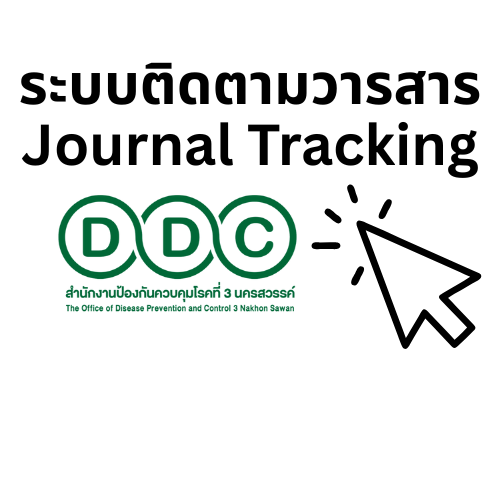Treatment Program of Anemia in Pregnant Women
Abstract
Introduction: Iron anemia in pregnancy is the major public health problem in the world, especially in South Asia which shows the highest prevalent (65%). In Thailand, it was found that 20.9% of pregnant women suffered moderate and severe anemia. This is higher than the nation’s goal which should not more than 10%. Moreover, the trend of iron anemia in pregnancy is increasing gradually each year.
Objectives: 1) to study and analyze service arrangement and management in solving pregnancy anemia problem in the study area, 2) to study and analyze service utilization of pregnant women on practice for iron anemia prevention and correction in the study area, 3) to study the factors affecting practice for iron anemia prevention and correction among pregnant women in the study area.
Methods: The qualitative method with deep interviewed was employed. Target areas were under the responsibility of regional health promotion center 7, 8 and 12. Each center, two Amphors which the highest prevalent of pregnancy anemia and 2 Amphors which the lowest prevalent of pregnancy anemia were selected. Therefore, there were 12 Amphors were selected from those 3 centers. The participants comprised of public health staffs who were working in the Community Hospitals and Tambon Health Promoting Hospitals and 119 pregnant women who attended the ANC service. Data collection was in April to July 2014. Content analysis was applied for analyzing the data. Approval for this study has been obtained from the Human Research Ethical Committee of regional health promotion center 8, Nakornsawan.
Results: There were no written policies about anemia in pregnancy. However, there were only ANCs which provided as the CPG of the hospital. At Amphor level, neither plan nor project was applied for prevention anemia in pregnancy. The treatments for pregnancy anemia, mostly applied as the guidelines. About compliance on taking the pills of the pregnant women found that 12 patterns in the normal pregnant woman and 13 patterns in pregnancy anemia. The first visit to ANC of pregnant women was similar between the high and the low prevalent of pregnancy anemia. They recognized their anemia status from the staff. They knew the effect of anemia on the fetus’s brain and the body such as small gestational age, poor health, and disability. In Amphor that had low prevalent of anemia, the anemia pregnant women did not know about the kinds of food that should be consumed and also the name of the pill as the name is in English language. However, they knew that the supplementation was for increasing blood, calcium, and B complex vitamin. The reason for taking the pills was for blood, brain and bone formation. All pregnant women understood the method of consuming the pill and consumed as the recommendation from the staff and reading from the labeling. In the Southern, it was found that the pregnant women had difficult in consuming the pill and would not consume when they had side effect such as nausea, vomiting, and boring for pill. In the North-eastern and Northern, although the pregnant women had side effect from the pill similar to in the Southern, they still consumed the pill because the physician repeated them on taking the pills and taking all. In case of nausea, vomiting, and could not take the pill, the physician recommended changing the time for taking the pill.
Recommendation: 1) The CPG for caring the anemia in pregnancy should be clear for practice in each level. 2) The ANC’s staff should be continuous trained in nutrient need in pregnancy. 3) The information on knowledge and practice for pregnancy should be emphasized on supplementation and guideline for taking the pill, together with consuming the iron rich food via variety media and channel that appropriate to the area context.
References
2.ยงยส หัตถพรสวรรค์ และคณะ. การศึกษาประสิทธิผลของการดูแลภาวะโลหิตจางจากการขาดธาตุเหล็กของหญิงตั้งครรภ์ในสถานบริการสาธารณสุขของรัฐในประเทศไทย; 2556
3. พีรพงศ์ อินทศร และประเสริฐ ศันสนีย์วิทยกุล. ความผิดปกติทางโลหิตวิทยาขณะตั้งครรภ์ในสูติศาสตร์. กรุงเทพฯ: พี.เอ.ลิฟวง; 2545.
4. รายิน อโรร่า, ชยันตร์ธร ปทุมานนท์, ชไมพร ทวิชศรี. ภาวะโลหิตจางในสตรีตั้งครรภ์ที่มาฝากครรภ์ ณ โรงพยาบาลลำปาง : ความชุก สาเหตุ ปัจจัยเสี่ยง. ลำปางเวชสาร; 2552. มค.-เมย. หน้า 28-37.
5. มนัสมีน เจะโนะ. ผลของโปรแกรมการสนับสนุนและให้ความรู้เพื่อลดภาวะโลหิตจางต่อพฤติกรรการดูแลตนเองของหญิงตั้งครรภ์มุสลิม. วิทยานิพนธ์พยาบาลศาสตร์มหาบัณฑิต สาขาวิชาการพยาบาลผดุงครรภ์ขั้นสูง มหาวิทยาลัยสงขลานครินทร์; 2555.
6. ศุภิสรา วรโคตร, ผ่องศรี เถิงนำมา, นันทา ศรีนา, ปราณี ธีรโสภณ. ผลการพัฒนาแบบคัดกรองภาวะโลหิตจางเบื้องต้นในหญิงวัยเจริญพันธุ์โดยอาสาสมัครสาธารณสุข ตำบลเพ็ญจันทร์ อำเภอเต่างอย จังหวัดสกลนคร. วารสารการพยาบาลและการศึกษา; 2554. สค.หน้า 2-9.
7. ศิรินทร์ทิพย์ วัชระไพโรจน์. โครงการการเฝ้าระวังภาวะโลหิตจางจากการขาดธาตุเหล็กในหญิงตั้งครรภ์. งานเวชปฏิบัติครอบครัวและชุมชน โรงพยาบาลไชโย จังหวัดอ่างทอง; 2554.
8. Mumtaz, Z., Shahab, S., Butt, N., Rab, M. A., & DeMuynck, A. (2000). Daily iron supplementation is more effective than twice weekly iron supplementation in pregnant women in Pakistan in a randomized double-blind clinical trial. J Nutr, 130(11), 2697-2702.
9. Hyder, S. M., Persson, L. A., Chowdhury, A. M., & Ekstrom, E. C. (2002). Do side-effects reduce compliance to iron supplementation? A study of daily and weekly dose regimens in pregnancy. J Health Popul Nutr, 20(2), 175-179.
Downloads
Published
How to Cite
Issue
Section
License
Copyright notice
Article published in the Journal of Disease and Health Risk DPC.3 Nakhon Sawan. It is considered a work of academic research and analysis as well as the personal opinion of the author. It is not the opinion of the Office of Disease Prevention and Control 3, Nakhon Sawan. Or the editorial team in any way Authors are responsible for their articles.
Privacy Policy
Name, address and e-mail address specified in the Journal of Disease and Health Risk DPC.3 Nakhon Sawan. It is used for identification purposes of the journal. And will not be used for any other purpose. Or to another person.








